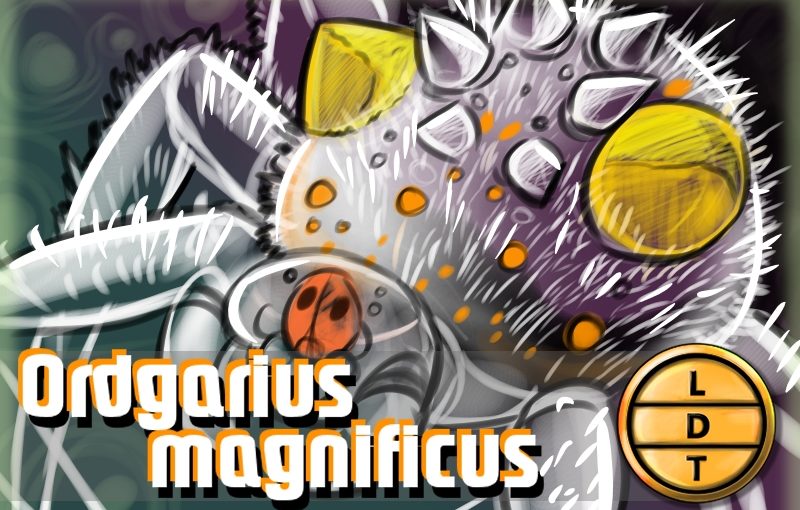“…and today we’re talking about a spider that’s truly magnificent. But more on that in a few minutes.”
Australia is no stranger to animals that do things differently. The denizens of the large island often have to carve their own path. It’s not surprising that the continent’s animals are often as intrepid and undaunted by challenges as its people. But innovation and the skills to use them is how some creatures chose to wrangle their goals in Life, Death, and Taxonomy.
Description
- The magnificent bolas spider is not as magnificent as its name might sound, though it does have an interesting look.
- Females have a huge, heart-shaped abdomen that is covered in white hairs and little orange pimples or sunspots. The patterns are pretty intricate. Looks like Okami the spider.
- Near the sides of the abdomen, there are two yellowish-green “horns” that stick out.
- There are also a bunch of spikes near the spider bum
- Its cephalothorax is much smaller than the abdomen and has both white and brownish hairs on it. It also has a kind of spiked crown of white appendages coming out of the top of its head
- The legs are a kind of see-through greenish or brown and have striped bands at the joints
Measure Up
Welcome to the beloved Measure Up segment. The official listener’s favorite part of the show! The part of the show when we present the animal’s size and dimension in relatable terms through a quiz that’s fun for the whole family. It’s also the part of the show that’s introduced by you when you send in audio of yourself saying, singing, or chittering the words measure up into ldtaxonomy at gmail dot com. We have a new measure up intro this week from Henry.
Female Size
- The female is around 1.4 cm – 2.5 cm (female)
- 2.5 cm
- How many bolas females go into the length of The River Murray, which might be the longest river in Australia?
- Hint: The River Murray flows from from the Australian Alps to the Southern Ocean.
- 100,320,000 spiders. The river is 2,508 km (1,558 mi)
Male size
- 1.5 mm (male)
- How many male bolas spiders go into the highet of the highest tennis ball catch.
- Hint: The catch was made by serial Guinness record breaker Anthony Kelly, in Armidale, New South Wales, Australia. He’s also caught a tennis ball fired at 200 kph (124 mph) and he caught 11 tennis balls in a minute blindfolded.
- 80,000 spiders. The catch was from 120 m (393 ft 8.4 in).
Major Fact: The Brilliant Bolas
The bolas spiders are related to orb weavers, which traditionally make large intricate webs to catch prey.
- But the bolas spider isn’t one for tradition.
- Bolas spiders really like moths as food. They can’t get enough of those sad hairy sack-cloth butterflies.
- But typical spider webs are very bad at catching moths.
- Moths are covered in tiny detachable hairs.
- These hairs can sometimes irritate humans, especially in the North american Species Browntail Moths.
- When a moth comes into contact with something like a web, the hairs slough off, allowing it to escape.
- For spiders, it’s like trying to have fun with a dirty sticky hand that you got from a boomers ticket exchange.
- Bolas spiders still produce silk, but instead of an intricate web, they produce one strand of silk with a sticky glob of viscous silk.
- It’s like fishing with a booger.
- When a moth gets close, the spider will swing the bolas into the moth.
- Since this blob is more viscous than normal webbing, it seeps through the moths little hairs and attaches with a more reliable grip.
- But since they don’t have a web with a wide surface area, they need another way to bring the moths in close for the catch.
- To do this, they release chemicals that mimic the pheromones of female moths.
- The male moths come in close and the bolas spider feels his approach with tiny hairs that are sensitive to vibrations called trichobothria.
- When they get close enough to investigate, they get bolased!
- But different moths have different pheromones, so can she just eat one type of moth? NOPE!
- She has a full arsenal of different chemical scents and she chooses based on what species is around!
Range
It lives in the dense forests of eastern/southeastern Australia. Mostly in Queensland and New South Wales.
Diet
They pretty much only eat moths and other small flying insects they can catch.
Ending: Whelp, that’s a wrap! For you out there in podcastia, show your colors, be patient when hunting, and always remember to glob efficiently like the Magnificent Bolas Spider here in LDT.

